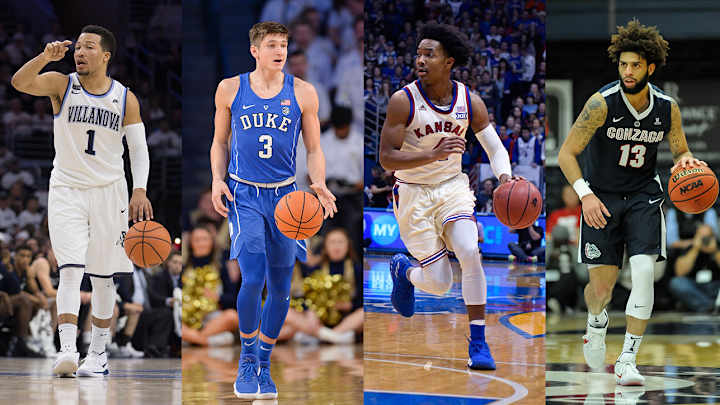The Magic Eight: One of These Teams Will Win the NCAA Tournament in 2018

Predicting college basketball’s national champion is a treacherous enough prospect when the NCAA tournament field is actually set. Picking one in mid-February is a fool’s errand, but for nearly two decades now, in a tradition begun by Grant Wahl and carried on by Luke Winn, SI.com has ventured to do just that. The key, however, is to pick not one team, but a pool of eight from which the eventual national champion will emerge.
Of course, the Magic Eight is not as simple as just listing the eight best teams in the country. Tradition dictates that the degree of difficulty be upped by excluding at least two of the top eight teams in the current AP poll, and including at least one team from outside that poll’s top 15. With the blessing of Luke, now ensconced in the Toronto Raptors’ front office, I present to you this year’s Magic Eight, in no particular order:
Virginia (24-2, 13-1 ACC)
Picking the current No. 1 team in the country seems as safe a choice as any, but the Cavaliers don’t exactly have the usual profile of a national champion. Their offense currently ranks 44th in adjusted efficiency; in the KenPom era (since 2002), only one team has entered the tournament with an offense ranked lower than 21st. That was the UConn team whose offense was the country’s 57th-most efficient in 2014, in one of the least predictable and least replicable tournament runs of the modern era. Virginia doesn’t have Shabazz Napier, but what it does have is the most efficient defense we’ve seen in the 16 seasons of KenPom data. The Cavs were a better scoring team the seasons of their 2014 and 2016 second-weekend flameouts, but they’ve never had a defense this good—nor has anyone in a long time. It could be good enough to finally bring a title to Charlottesville.
Purdue (23-4, 12-2 Big Ten)
When you look for championship-level balance, the Boilermakers offer as good a profile as anybody’s. They currently rank third in offensive efficiency and 14th on defense, joining Michigan State and Gonzaga as the only teams in the top 20 on both ends of the floor, a distinction shared by 10 of the last 16 national champions. There’s also a balance in their roster: 7’2” big man Isaac Haas is a post-up machine, and the four starters around him all shoot at least 39.9% from three. The two starting Boilermakers who shoot the least often— Dakota Mathias and P.J. Thompson—are actually their two most efficient scorers, meaning there really isn’t anyone defenses can ignore. And Purdue boasts a very experienced roster, starting four seniors and a sophomore who might be their most explosive scorer in guard Carsen Edwards. There’s no obvious hole here.
Michigan State (25-3, 13-2 Big Ten)
As mentioned above, the Spartans rank in the top 20 in efficiency on both offense (ninth) and defense (fifth) and even before Saturday’s win against Purdue had been closer to looking like a national title contender than many had given them credit for. Perhaps that’s because Michigan State’s only previous win against a team currently in the top 35 of KenPom’s efficiency rankings had been in November against an all-over-the-place North Carolina team, although that discounts a Nov. 30 win over pre-injury-plague Notre Dame. Anyway, the Spartans don’t take care of the ball particularly well and don’t do much damage from outside, but they do have an elite interior defender (Jaren Jackson Jr.), two NBA lottery talents (Jackson and Miles Bridges), and one of the best-assisting point guards out there (Cassius Winston). And that Tom Izzo guy has won some games in March.
Villanova (23-2, 10-2 Big East)
The worst an eventual national champion has been ranked in pre-tourney defensive efficiency has been 37th, accomplished by both 2009 North Carolina and 2015 Duke; Jay Wright’s squad currently ranks 48th. This team entered its conference schedule top-10 in that category, but has since ranked eighth in the Big East during league play. Still, no other team has a tandem of All-America candidates that can match the Wildcats’ Jalen Brunson and Mikal Bridges, with sophomore Donte DiVincenzo growing into one of the country’s most dangerous third options alongside them. Villanova also gives away very few possessions (its turnover rate is the country’s third-lowest), shoots with extreme effectiveness (third in effective field goal percentage), and starts two players who were part of a previous title team (three if you count Eric Paschall, who was redshirting in 2015-16). The Wildcats have been all-or-nothing in recent postseasons, and this year’s defense thus far is the worst they’ve had since missing the tournament in 2012. But there’s reason to believe this offense is good enough to make this season one for the books.
Arizona (20-6, 10-3 Pac-12)
The Wildcats are barely outside the AP top 15 (they rank 17th) and currently lead a power conference by two games, but this is a riskier pick than those facts suggest. Arizona’s pre-tournament defense is currently worse than all but one Final Four team of the last 16 seasons (VCU in 2011, which benefited from the atypicality of Shaka Smart’s Havoc press) and ranks a full 69 spots lower than the worst defense to have won it all. So why include them? For one, their inside-outside combo of junior wing Allonzo Trier and freshman big man Deandre Ayton is as good as anyone’s. Also, history has shown that the best iteration of the AP poll for predicting tournament success is the preseason one; in that, the Wildcats were tabbed the No. 3 team in the country. Sean Miller still has a lot of work to do with this defense, his leakiest since his first season in Tucson in 2009-10, but has proven himself as a defensive coach in the past. Now he has to pull this one together for its best three-week stretch to date.
Duke (20-5, 8-4 ACC)
The Blue Devils’ inclusion is most justified by their past and future selves: the team everyone expected them to be before the season, when they entered the year ranked No. 1, and the team they may be a month from now. Duke’s defense has been an issue for months, but with such a young team and such a bevy of offensive talent—all under the tutelage of one of the game’s best coaches ever—it’s not wholly unreasonable to think that some light bulb might switch on over the next seven weeks. Marvin Bagley III will be (arguably, at worst) the best player on the floor in all of their games, and is it that hard to imagine Grayson Allen going out with that kind of bang? If the defense and point guard situation improve, there isn’t a team in this range with a higher ceiling.
Gonzaga (23-4, 13-1 West Coast)
Just sneaking into the top-20-on-both-ends club over the weekend, the Zags are surprisingly unheralded for a name-brand program coming off a national title game appearance and playing at this level. Their resume doesn’t wow you — before beating Saint Mary’s last week, they hadn’t had a notable win since the beginning of December — but they have the kind of balance you look for in a championship profile and a strong interior combo in Johnathan Williams and Killian Tillie, with sophomore Rui Hachimura having the kind of talent to emerge as a difference-making March reserve a la Zach Collins a year ago. Maybe they follow North Carolina’s lead from last season and go from runner-up to champ.
Kansas (19-6, 8-4 Big 12)
They don’t have interior depth. They’re too dependent on jump shots. They may finally not win the Big 12 title. But how many teams have more quality wins than the Jayhawks? Going by the NCAA’s new quadrant system, they have nine Quadrant 1 wins (against four losses), which leads all teams, and they’ll have the chance to pick up at least three more. They’ve gone from being the country’s worst team at getting to the free throw line to nearly doubling their rate in Big 12 play. We have yet to see the best of Lagerald Vick and Malik Newman at the same time. If those two are both clicking and Devonte Graham plays like he did in the first three rounds last year, this supposedly disappointing Kansas team could prove reports of their death greatly exaggerated.
Notable omissions
Xavier: Doing this just days after the selection committee revealed its current top 16 teams, I gave myself the additional challenge of excluding a No. 1 seed. The Muskies were the odd men out because of their defense (59th in efficiency) and their being 7-0 in games decided by five points or less, suggesting that they are a few wrong bounces away from a slightly less impressive resume.
Cincinnati and Texas Tech: Two of the country’s best defensive teams get left out due to lack of offensive firepower. If there’s one player between these two who might have a little Shabazz Napier to him, it’s the Red Raiders’ Keenan Evans, who recently posted back-to-back 30-point games in late January. And to the city of Cincinnati, I swear I harbor no ill will, and am in fact wearing a Rhinegeist T-shirt as I type this.
Ohio State: Perhaps I should apologize to the entire state of Ohio. The Buckeyes don’t have a quality win outside of the Big Ten and lost decisively to Gonzaga, Clemson and North Carolina. Getting a top-four seed and possible Big Ten title will make this a truly remarkable season in Chris Holtmann’s first year, but it’s hard to see them adding the top hardware to their bounty.
Auburn: The Tigers play fast and with a youthful confidence, and their defense is trending in the right direction. But their lack of size and experience concern me, as does the fact that Tennessee might be the only single-digit seed they’ve beaten so far.
North Carolina: The defending champs have not proven to be very trustworthy, losing home games to Wofford and North Carolina State even while beating Duke, Ohio State, Tennessee, and Clemson, among others. It’s too easy to foresee another lapse to predict another title.
Clemson: The ACC’s surprise team has had a middle-of-the-road offense in conference play and its only starter with NCAA tournament experience is guard Marcquise Reed, who reached the dance with Robert Morris in 2015. The good news: with four starters due back next year, this could be the precursor to a better 2019 showing.
Oklahoma: There may be no better candidate than Trae Young to become this tournament’s takeover artist who keys a surprise title run. But the Sooners’ defense and their recent struggles as Young has proven mortal make Oklahoma seem like a highly entertaining potential second-weekend team, but not a national champ.
